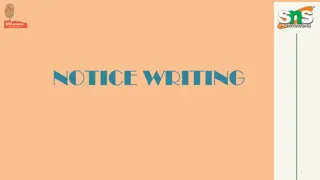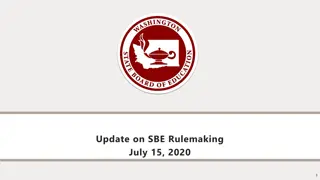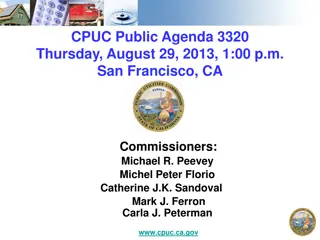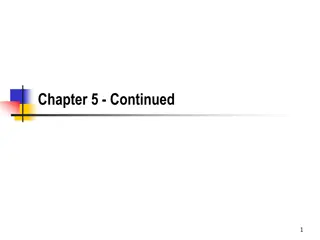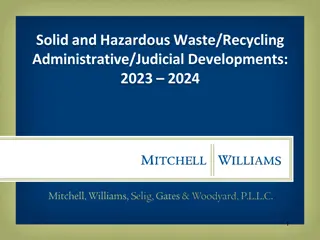Exploring Notice-and-Comment Rulemaking Procedures
Dive into the complexities of notice-and-comment rulemaking through real case studies and legal analysis, covering topics such as revision notices, logical outgrowth tests, disclosure of technical information, and published record additions. Understand the implications of regulatory changes and court rulings in various sectors like environmental regulations and industry standards.
Download Presentation

Please find below an Image/Link to download the presentation.
The content on the website is provided AS IS for your information and personal use only. It may not be sold, licensed, or shared on other websites without obtaining consent from the author. Download presentation by click this link. If you encounter any issues during the download, it is possible that the publisher has removed the file from their server.
E N D
Presentation Transcript
The Procedures of Notice-and-Comment Rulemaking 1
When Do You Need To Re-Notice a Revised Rule? 2
Chocolate Manufacturers Assn v. Block, 755 F.2d 1098 (4th Cir. 1985) What is WIC? What evil substance in what food did the proposed rules propose to regulate? How was the final rule different from the proposed rule? What new product was regulated? 3
The Notice Problem What was the CMA's claim? What was the agency defense? Does the rule have to be the same? Why have notice and comment then? What is the logical outgrowth test? How would you use it in this case? What did the court order in this case? What will the CMA do if a new proposed rule includes them? 4
Limits on Logical Outgrowth - Arizona Public Service Co. v. E.P.A. What did the EPA propose that Indian Tribes be allowed to do that states were doing? State plans are subject to judicial review Why did the tribes object to this in comments? How was the rule changed? What was the claim by plaintiffs? How did the court analyze the problem? Why shouldn't the change have been a surprise? 5
What about Technical Information Underlying the Rule? (not in book) Portland Cement v. Ruckelshaus, 486 F2d 375 (1973) The agency must disclose the factual basis for the proposed rule, if it relied on scientific studies or other collections of information. Connecticut Light and Power v. NRC, 673 F2d 525 (1982)? The agency cannot hide technical information. Why is this a big deal in environmental regs? What are the potential downsides of this policy? 6
Additions to the Published Record (not in book) 7
Rybachek v EPA, 904 F.2d 1276 (1990) Gold mining under the CWA. In a dubious reincarnation of the 1890's world of Yukon poet Robert Service, we deal here a century later with strange things done in the midnight sun by the men who moil for gold. , quoting The Cremation of Sam McGee EPA added 6000 pages of supporting info when responding to comments The agency may supplement the rulemaking record in response to comments asking for explanation. 8
Idaho Farm Bureau Federation v. Babbitt, 58 F.3d 1392 (9th Cir. 1995) Endangered Species Act listing. Agency added a report to the record when it replied to comments, then relied on it in the final rule. The agency may not add new material and then rely on it without given an opportunity to comment on it. 9
Negotiated Rulemaking What is this? Why is often used in environmental rulemaking? What are the advantages? What are the public participation issues? Assume you are regulating wood stoves Which groups are most likely to be able to participate? 11
Negotiated Rulemaking and Notice and Comment The negotiation happens before the rule is proposed in the FR. The standards for publication and notice are the same as for all other notice and comment rules. This solves any ex parte contacts problem because the rule must be fully justified by its published record. Interested parties can still comment. 12
Ex Parte Communications in Litigation What is an ex parte communication in litigation? Why do we ban them in litigation? If a party in a lawsuit wants to talk to the judge, how are ex parte contacts avoided?
Ex Parte Communications in Rulemaking How does the notice provision in rulemaking change the issues in ex parte communications? Why aren t ex parte communications before the promulgation of the rule a problem? When could ex parte communications be an issue? How can you cure this? The key is whether the published record supports the rule. 14
Sangamon Valley Television Corp. v. U. S., 269 F.2d 221 (D.C. Cir. 1959) This is an old case. While it is a rulemaking on allocation of the electronic magnetic spectrum, it really resembles an old ratemaking because it involves a very small number of identified parties. It might better be seen as an adjudication. There were ex parte contacts, which were not on the record, and the court found this a problem. 15
Bias and Prejudice Why do we worry about bias and prejudice in litigation? What was the trade off in adjudication, where we accept potential sources of bias that would not be acceptable in an Article III trial? How does the process of rulemaking minimize the bias and prejudice problem? 16
Association of National Advertisers , Inc. v. FTC, 627 F.2d 1151 (D.C. Cir. 1979) FTC is adopting rules on TV advertising directed at children. Chairman has written and spoken at length on the evils of TV ads aimed at children Plaintiffs seek to disqualify him because of bias Court held that plaintiffs must show clear and convincing evidence that he has an unalterably closed mind on matters critical to the rulemaking No rulemaking has ever been overturned on the basis that a decisionmaker was unlawfully prejudiced. 17
DC Federation of Civic Associations v. Volpe, 459 F.2d 1231 (D.C. Cir. 1971) (not a rulemaking) Congress pressures DOT to build a bridge in DC. Plaintiffs claim that the Secretary gave into the pressure. The Volpe test 1) was there specific pressure on the agency to consider improper factors? 2) did the agency in fact change its mind because of these considerations? How can the agency defend itself from a Volpe attack? After Overton Park, this can be better seen as a case where the Secretary did not properly document his decisionmaking in the record. 18
Sierra Club v. Costle, 657 F.2d 298 (D.C. Cir. 1981) Rulemaking on coal fired power plants Why is this controversial then and more so now? Plaintiffs claimed that the president influenced the agency decision after the comment period. Is that wrong? Senator Bird also weighed in What do plaintiffs need to show to establish undue influence? Why is the outcome test, combined with the record, a good solution? 19
What is the President's Role in Rulemaking? (not independent agencies) Controls and supervises executive branch decisionmaking What just happened with the ozone regs? How is the role different in adjudications? When should the president's contacts be documented? When the statute requires that they be docketed If the rule is based on factual information that comes from such a meeting. 20
Should State Rules Differ from Federal Rules on Notice and Comment? Limited staff Greater reliance on the expertise of board members, rather than staff Board may hear lots of testimony and review a lot of info - they cannot afford the time and effort to put together volumes of supporting info for regs What about LA's 300+ tiny boards? Should state agencies have a reduced publication requirement? Should they be able to publish rules without explanation and only have to explain if asked? 22
Congressional Mandates (Hybrid Rulemaking) at the FTC issue an advance notice of proposed rulemaking, which describes the area of inquiry under consideration and invites comments from interested parties; send the advance notice and, 30 days before its publication, the notice of proposed rulemaking to certain House and Senate committees; hold a hearing presided over by a hearing officer at which persons may make oral presentations and in certain circumstances to conduct cross-examination of persons; include a statement of basis and purpose to address certain specified concerns; and conduct a regulatory analysis of both the proposed and final rules that describes the proposal and alternatives that would achieve the same goal and analyzes the costs and benefits of the proposal and the alternatives. 23





